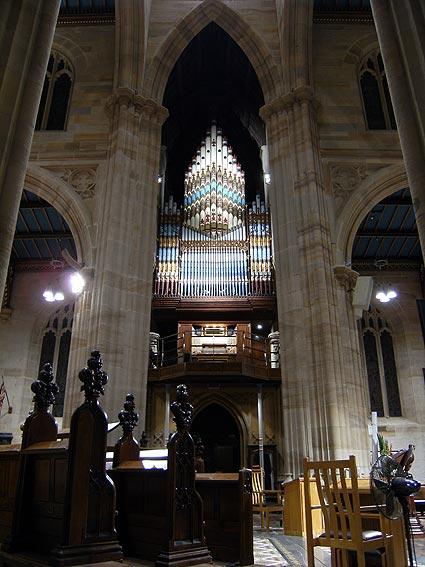 |
| Photo courtesy of SOMS |
The programme was as follows:
Rondeau from Abdelazar -- Henry Purcell (1659-1695)
Prelude & Fugue in d minor (Op. 37, No. 3) -- Felix Mendelssohn (1809-47)
Lindemann Variations -- Mark Viggiani
Maestoso from Sonata in c# (Op. 5) -- Basil Harwood (1859-1949)
As you will observe, there was a certain amount of anniversary-keeping in the choice of pieces.
The Mendelssohn piece is not commonly played, for reasons I haven't really ever fathomed. It belongs to a different stylistic world to the other two preludes and fugues in the set; my perspective on this piece is that it really conjures the spirit of Buxtehude much more powerfully than the feeling of Bach one gets from the c minor prelude and fugue. The d minor can certainly be analyzed as a multi-sectional toccata with an extended fugue at the end, a procedure that many organists would be familiar with from their studies of the praeludia of Buxtehude and early Bach.
The Harwood piece was chosen on account of his associations with St Barnabas, Pimlico, the site of Kensitite riots during the Catholic Revival in the Church of England. Harwood went on to be organist at Ely and Christ Church, Oxford, before retiring on inheriting the family estates on the death of his father in 1909. There was a certain frisson about playing such luxuriantly high church music in the citadel of Australian Evangelicalism.
The Harwood piece is interesting on several levels. It is based on a plainsongy sort of melody associated with the office hymn for Lauds on Whitsunday and its octave. For your edification, here is the text, which is attributed to Hilary of Poitiers:
Beata nobis gaudia
Anui reuxit orbita
Cum Spiritus paraclitus
Illapsus est Apostolis
The circle of the year has again
Brought back to us blessed joys,
When the Spirit, the Comforter,
Came down upon the Apostles.
The melody is quoted in full at the end of the movement, and you'll hear it on the vox humana.
Harwood's Op. 5 Sonata was dedicated to Walter Parratt, whose main contribution to Harwood's development as a composer for the organ was to discourage him from composing a second organ sonata shortly after the successful reception of the first. Instead, there is a group of pieces which can be conjectured as the movements of what should have been the next sonata: the Dithyramb is known to have been in this group. There is another organ sonata, but it belongs to a considerably later period in Harwood's life and has a completely different set of ideas going on in it.
This is an absolutely live concert recording, which means that the person minding the recording device got chatty occasionally, and you can hear the bells in the tower of the town hall next door during a couple of the pieces. That's authenticity for you!
No comments:
Post a Comment